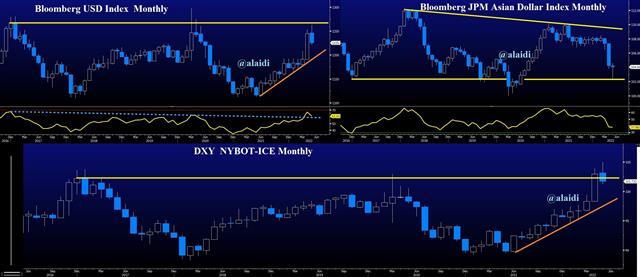You must've seen May's monthly charts, highlighting the wild Doji candles for the S&P 500 and Dow Jones Industrial Average, where the open price for the month equaled the close, with as much as -7.7% and +4.5% intra-month downside and upside respectively.
This should fortify the position of both bulls and bears --the former stating the worst is over and we're close to the end of Fed hikes, the latter indicating earnings weakness, the start of Fed QT this week, and inflation pullback being only...transitory).
But what about the US monthly charts for various USD indices?

The upper left chart shows the Bloomberg USD index (BBDXY) – a basket of 10 currencies (EUR 32.7%, JPY 14.6%, CAD 11.94%, GBP 11.5%, MXN 9.95%, AUD 5.15%, KRW 3.43%, CNH 3.0% and INR 2.96%). Bloomberg has been (rightly) active in pushing its index. It is a more accurate and increasingly used USD index as far as the greenback's performance vis-à-vis currencies by the relevance of their trade relationship with the US. And unlike the Fed's Broad US Dollar Index (not included here), the BBDXY is not scattered over too many currencies.
The upper right chart shows the Bloomberg JP Morgan Asian Dollar Index (ADX), which focuses on the USD's performance versus Asian currencies.
NOTE: A rising graph indicates strengthening in Asian FX vs. USD and not the other way round.
This trading bloc is well known for its disparate economic cycles relative to the US. This means Asian monetary policies often lead the US by 6 or 9 months. The widening (and broadening) role of the Chinese yuan is starting to make the index appear as the China equivalent of the Eurozone mirror image in the case of DXY (see below)
The usefulness of distinguishing the ADX from DXY indices can usually be understood with the help of China's appetite for commodities, specifically metals. (This is covered in more detail in a previous post here).
The bottom chart shows USDX Index (DXY), the most widely traded/followed US dollar index (traded at the ICE (NYSE:ICE)). This is a basket of 6 currencies (EUR 57.6%, JPY 13.6%, GBP 11.9% and CAD 9.0% and SEK 4.2% and CHF 3.6%). The heavy euro weighting means the index is largely a mirror image of the euro and has little to do with the increasingly powerful Asian currencies.
What stands out
The lower highs in the Bloomberg USD Index (BBDXY) over the past 5 years capture the USD's inability to regain its highs vs. the tightening policies of AUD, CAD, and MXN. This failure is best highlighted in the May close. Nonetheless, USD bears have little reason to worry as long as 1180 in BBDXY is held.
The deep drop in ADX during April and May was mainly a result of easing initiatives from the People's Bank of China in light of fresh lockdowns and troubled real-estate assets. The stabilization around 102 could appear as right shoulder support, but more policy guidance is awaited from Beijing.
Finally, DXY is the best performing index of the three due to its significant weighing against the troubled euro (past 4 months). USD bears could point to DXY's failed attempt to close above the highs from March 2020 and Jan 2017, while USD bulls will likely focus on the ability of the April candle (second to last) to close above those highs.
Looking ahead
FX traders focusing on USD pairs need to figure out two things this month: i) to what extent will the market stick to this newfound focus/concern with growth rather than inflation; ii) China's ability to re-open its economy rigorously and restore the supply chain problem. We could add the obvious third factor of the Ukraine-Russia war, but at present, the first two will do.
The 1st factor can be invalidated once US-10 year yields break (and holds) above 3.0%. In such a case, inflation concerns would revert as the center of market attention, propping USD and weighing on indices, i.e., bond yields will restore the negative correlation with indices seen so far this year. Today's ISM manufacturing figures show no signs of the slowdown alerted to in this post.
In fact, markets are gradually getting rid of factor (i) and reverting to fully discounting a 3rd 50-bp rate hike (in Sept). But as you very well know, with 3-months pricing, this could easily change from one month to another.

